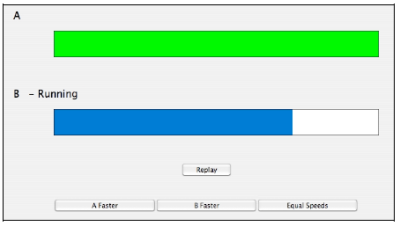Inhaltsverzeichnis
Studies breakdown and topic preparation (2018-12-28)
Tagged as: blog,study, topic. design
Group: H
Finalization of the study search and topic preparation
We chose the study „Faster Progress Bars: Manipulating Perceived Duration with Visual Augmentations“ to work with and replicate that study.
Preparation
Chris Harrison points out that „research has shown that the perceived duration of progress bars can be manipulated by changing how they move (e.g., pauses, accelerations)“ (http://www.chrisharrison.net/index.php/Research/ProgressBars2)
In the following video the visualization of the different progress bars and menues is shown: https://www.youtube.com/watch?v=CDnN3wLY3OE
Visualization by Harrison et al.:
Study 1
- Duration: 5 seconds
- Start frequency: 1.1 Hz
- End frequencies: 1.1 Hz, 1.17 Hz, 1.25 Hz, 0.95 Hz, 0.8 Hz
- 25 combinations to test all possibilities
Study 2
- 20 participants (same participants as in study 1)
- seven ribbed behaviors
- same study interface
- 49 distinct ordered pairs of the seven ribbed behaviors
- testing behaviors against themselves, and both orderings of any given pair
- randomized presentation order
Study 3
- 10 participants (5 female, mean age 19)
- relative perceived duration of the three progress bars at two different durations, 5 and 15 seconds
- each unique ordered pair of progress bars was presented to participants twice, for a total of 18 trials
- data from repeated trials was combined
- trial order was also randomized
- study was completed for both 5- and 15-second durations (36 comparisons in total) using the same interface as the previous two studies
Study 4
- 16 participants (6 female, mean age 22)
- eight rounds to find a perceptual equilibrium for each of the four conditions
- repeated twice (with data averaged together) for a total of 64 trials
- time that was added or subtracted to the ribbed progress bar duration decreased linearly each round, allowing for increasingly fine tuning
- value started at 25% of the total original duration, and then dropped by 5% each subsequent round
